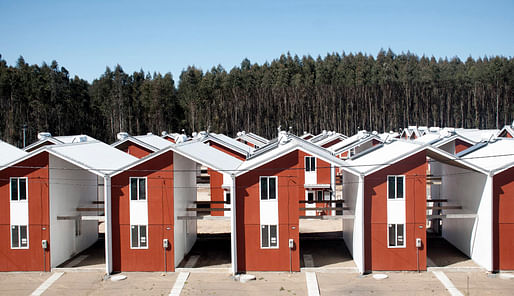

After Alejandro Aravena accepted the Pritzker Prize yesterday, his firm Elemental released four open source plans for low income housing that, according to the firm's website, balance the constraints of "low-rise high density, without overcrowding, with possibility of expansion (from social housing to middle-class dwelling)." The plans were released partly as a response to the looming housing crisis of 2030, in which it is estimated that two billion people will be living under the poverty line.

Aravena's self-described "incremental housing" is partly a governmental effort, and partly an individual one. By providing plans for proven models of sustainable housing, people can have greater agency in housing themselves. "Given the magnitude of the housing shortage, we won't solve this problem unless we add people's own resources and building capacity to that of governments and the market," reads Elemental's statement.

The four projects Elemental has released plans for are Quinta Monroy, Villa Verde, Lo Barnechea, and Mexico City's Monterrey, designs for which Elemental noted "are knowledge that we have tested, that have proved to be beneficial to communities and that have been implemented accepting very pressing budget and policy constraints."



For all of the plans, download them from Elemental's website here.
10 Comments
Wonder if this method will survive a more rigorous critique (or better, people). I mean, do they have to be so monotonous? And giving the designs away for free... what value does design have these days?
I saw Alejandro give a presentation some 10-years ago. Still to this day, it's one of the best I've attended.
open source plans that need to be engineered and adapted to local codes, local building materials, labor, heating/cooling, energy, sites, the list goes on and on. The gesture although noble has about as much value as seeing a presentation plan in arch record.
http://www.indomovie.tk/video/view/F0ZzwGSF6Zg/Sweet-Home-Alabama-Haitian-Money-Pit-VICE-on-HBO-Season-3-Episode-7.html
the segment about haiti is terrifying, see how many "designs" got built in the poorest country around here.
Nate Hornblower - I think they are done that way because they are meant to be customized and personalized by the residents.
I think their approach is that they know the residents will build whatever they need/can afford so might as well give them the basic structure (ie. roof and floor joists) so that they can enlarge their space. Must be fun not working with fire codes.
Yes, this concept is great, but I'm just wondering how much the customizatom is narrative vs reality. Every building gets customized to an extent, but where is the danger when architecture starts to have superficial customization features of an iPhone.
Obviously the work is being celebrated for good reason, but it looks quasi suburban. Think architecture suffers whenever we stop thinking of buildings as individual and unique.
I could bet the bulk of the cost in all these projects is underground, sanitation and power; which is what the world is lacking, anyone can build a roof and 4 walls, but without infrastructure you won't get too far.
^true.
the point of incremental construction is to bring the essentials, especially clean water and sanitation to an area previously built without that support. Its fucking smart. and its done without ego, which is pretty cool. Whether he deserves the pritzker or not is a bit of a question, but alejandro is without a doubt doing something special with this work.
Block this user
Are you sure you want to block this user and hide all related comments throughout the site?
Archinect
This is your first comment on Archinect. Your comment will be visible once approved.